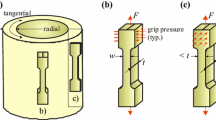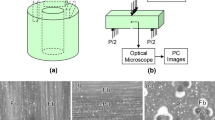Abstract
Bamboo has recently become a key material in green engineering. However, measuring its transverse elastic modulus (ET) is difficult due to the inherent structural properties of bamboo culm. In this study, two micromechanical analytical models, the Chamis model and Reuss model, and a finite element (FE) inverse numerical method were used to calculate the elastic modulus perpendicular to the bamboo grain by using a specially designed strip-reinforced polymer specimen. A bamboo veneer microtensile test was used to verify these approaches. The effect of the specimen geometry on measurement accuracy was also determined. This novel approach was also used to determine the ET of two bamboo species. The Chamis model had the best performance because its assumptions regarding the fiber section geometry were consistent with the actual specimen; the Reuss model had the worst results. The result of the FE method was slightly distorted due to the high sensitivity of parameters. A parametric study revealed that the micromechanics and FE descriptions of the modulus of the resin–fiber combination differed. The fiber volume fraction affected the prediction accuracy, but not the width or spacing of the bamboo strips. The strain and stress distribution of composite repeating units were studied. The results of ET measurements for the two bamboo species were reasonable. In conclusion, a novel, verified, simple, and accurate method was developed for determining the ET of bamboo.













Similar content being viewed by others
References
Akinbade Y, Nettleship I, Papadopoulos C, Harries KA (2021) Modelling full-culm bamboo as a naturally varying functionally graded material. Wood Sci Technol 55(1):155–179. https://doi.org/10.1007/s00226-020-01246-6
Askarinejad S, Kotowski P, Shalchy F, Rahbar N (2015) Effects of humidity on shear behavior of bamboo. Theor Appl Mech Lett 5(6):236–243. https://doi.org/10.1016/j.taml.2015.11.007
Chamis CC, Hopkins DA (1988) Thermoviscoplastic nonlinear constitutive relationships for structural analysis of high-temperature metal matrix composites (pp. 177–196). ASTM International, West Conshohocken
García JJ, Rangel C, Ghavami K (2012) Experiments with rings to determine the anisotropic elastic constants of bamboo. Constr Build Mater 31:52–57. https://doi.org/10.1016/j.conbuildmat.2011.12.089
Gauss C, Savastano H Jr, Harries KA (2019) Use of ISO 22157 mechanical test methods and the characterisation of Brazilian P. edulis bamboo. Constr Build Mater 228:116728. https://doi.org/10.1016/j.conbuildmat.2019.116728
Habibi MK, Samaei AT, Gheshlaghi B, Lu J, Lu Y (2015) Asymmetric flexural behavior from bamboo’s functionally graded hierarchical structure: underlying mechanisms. Acta Biomater 16:178–186. https://doi.org/10.1016/j.actbio.2015.01.038
Kanzawa E, Aoyagi S, Nakano T (2011) Vascular bundle shape in cross-section and relaxation properties of moso bamboo (Phyllostachys pubescens). Mater Sci Eng C-Mater Biol Appl 31(5):1050–1054. https://doi.org/10.1016/j.msec.2011.03.004
Kubojima Y, Inokuchi Y, Suzuk Y, Tonosaki M (2010) Shear modulus of several kinds of Japanese bamboo obtained by flexural vibration test. J Wood Sci 56(1):64–70. https://doi.org/10.1007/s10086-009-1047-z
Liu H, Jiang Z, Zhang X, Liu X, Sun Z (2014) Effect of fiber on tensile properties of moso bamboo. BioResources 9(4):6888–6898
Liu P, Zhou Q, Jiang N, Zhang H, Tian J (2020) Fundamental research on tensile properties of phyllostachys bamboo. Result Mater 7:100076. https://doi.org/10.1016/j.rinma.2020.100076
Mannan S, Paul Knox J, Basu S (2017) Correlations between axial stiffness and microstructure of a species of bamboo. Roy Soc Open Sci 4(1):160412. https://doi.org/10.1098/rsos.160412
Mascia NT, Nicolas EA (2013) Determination of Poisson’s ratios in relation to fiber angle of a tropical wood species. Constr Build Mater 41:691–696. https://doi.org/10.1016/j.conbuildmat.2012.12.014
Moran R, Ghavami K, García JJ (2017) A new method to measure the axial and shear moduli of bamboo. Pro Inst Civil Eng-Struct Build 170(4):303–310. https://doi.org/10.1680/jstbu.16.00045
Onyekwere OS, Oladeinde MH, Edokpia RO (2021) Multi-response optimization of bamboo fiber reinforced unsaturated polyester composites using hybrid Taguchi-grey relational analysis method. J Ind Prod Eng 38(2):98–107. https://doi.org/10.1080/21681015.2020.1848933
Raju B, Hiremath SR, Mahapatra DR (2018) A review of micromechanics based models for effective elastic properties of reinforced polymer matrix composites. Compos Struct 204:607–619. https://doi.org/10.1016/j.compstruct.2018.07.125
Reuss AJZAMM (1929) Computation of the yield point of mixed crystals due to hiring for single crystals. Math Phys 9:49–58
Shao ZP, Fang CH, Huang SX, Tian GL (2010) Tensile properties of Moso bamboo (Phyllostachys pubescens) and its components with respect to its fiber-reinforced composite structure. Wood Sci Technol 44(4):655–666. https://doi.org/10.1007/s00226-009-0290-1
Sharma B, Harries KA, Ghavami K (2013) Methods of determining transverse mechanical properties of full-culm bamboo. Constr Build Mater 38:627–637. https://doi.org/10.1016/j.conbuildmat.2012.07.116
Torres LA, Ghavami K, Garcia JJ (2007) A transversely isotropic law for the determination of the circumferential young’s modulus of bamboo with diametric compression tests. Latin Am Appl Res 37(4):255–260
Voigt W (1889) Ueber die Beziehung zwischen den beiden Elasticitätsconstanten isotroper Körper. (On the relationship between the two elasticity constants of isotropic bodies) (In German). Ann Phys 274(12):573–587. https://doi.org/10.1002/andp.18892741206
Wang F, Shao Z (2020) Study on the variation law of bamboo fibers’ tensile properties and the organization structure on the radial direction of bamboo stem. Ind Crop Prod 152:112521. https://doi.org/10.1016/j.indcrop.2020.112521
Yoshihara H, Tsunematsu S (2006) Feasibility of estimation methods for measuring Young’s modulus of wood by three-point bending test. Mater Struct 39(1):29–36. https://doi.org/10.1617/s11527-005-9015-6
Zhao X, Wang G, Wang Y (2018) Micromechanical modeling in determining the transverse elastic moduli and stress distributions of bamboo. J Mate Sci 53(4):2553–2565. https://doi.org/10.1007/s10853-017-1692-3
Zhou A, Huang D, Li H, Su Y (2012) Hybrid approach to determine the mechanical parameters of fibers and matrixes of bamboo. Constr Build Mater 35:191–196. https://doi.org/10.1016/j.conbuildmat.2012.03.011
Acknowledgements
This work was supported by the National Science and Technology Council, Taiwan [111-2313-B-002-055-MY3; 110-2313-B-002-044]. Special thanks to the College of Mechanical Engineering, National Taiwan University, for supporting the FE Software.
Author information
Authors and Affiliations
Contributions
C-WC and F-CC start the conceptualization and discuss the methodology. C-WC and H-WK conducted experiments and analysis. C-YL conducted Finite Element analysis and assisted visualization. C-WC wrote the first draft, and F-CC review and edited the manuscript. F-CC was also responsible for project administration and funding acquisition. All authors have reviewed the manuscript before submission.
Corresponding author
Ethics declarations
Conflict of interest
The authors declare that they have no known competing financial interests or personal relationships that could have appeared to influence the work reported in this paper.
Additional information
Publisher's Note
Springer Nature remains neutral with regard to jurisdictional claims in published maps and institutional affiliations.
Rights and permissions
Springer Nature or its licensor (e.g. a society or other partner) holds exclusive rights to this article under a publishing agreement with the author(s) or other rightsholder(s); author self-archiving of the accepted manuscript version of this article is solely governed by the terms of such publishing agreement and applicable law.
About this article
Cite this article
Chang, CW., Lin, CY., Kao, HW. et al. Micromechanical analytical and inverse numerical modeling methods for determining the transverse elastic modulus of bamboo. Wood Sci Technol 57, 75–92 (2023). https://doi.org/10.1007/s00226-022-01445-3
Received:
Accepted:
Published:
Issue Date:
DOI: https://doi.org/10.1007/s00226-022-01445-3




